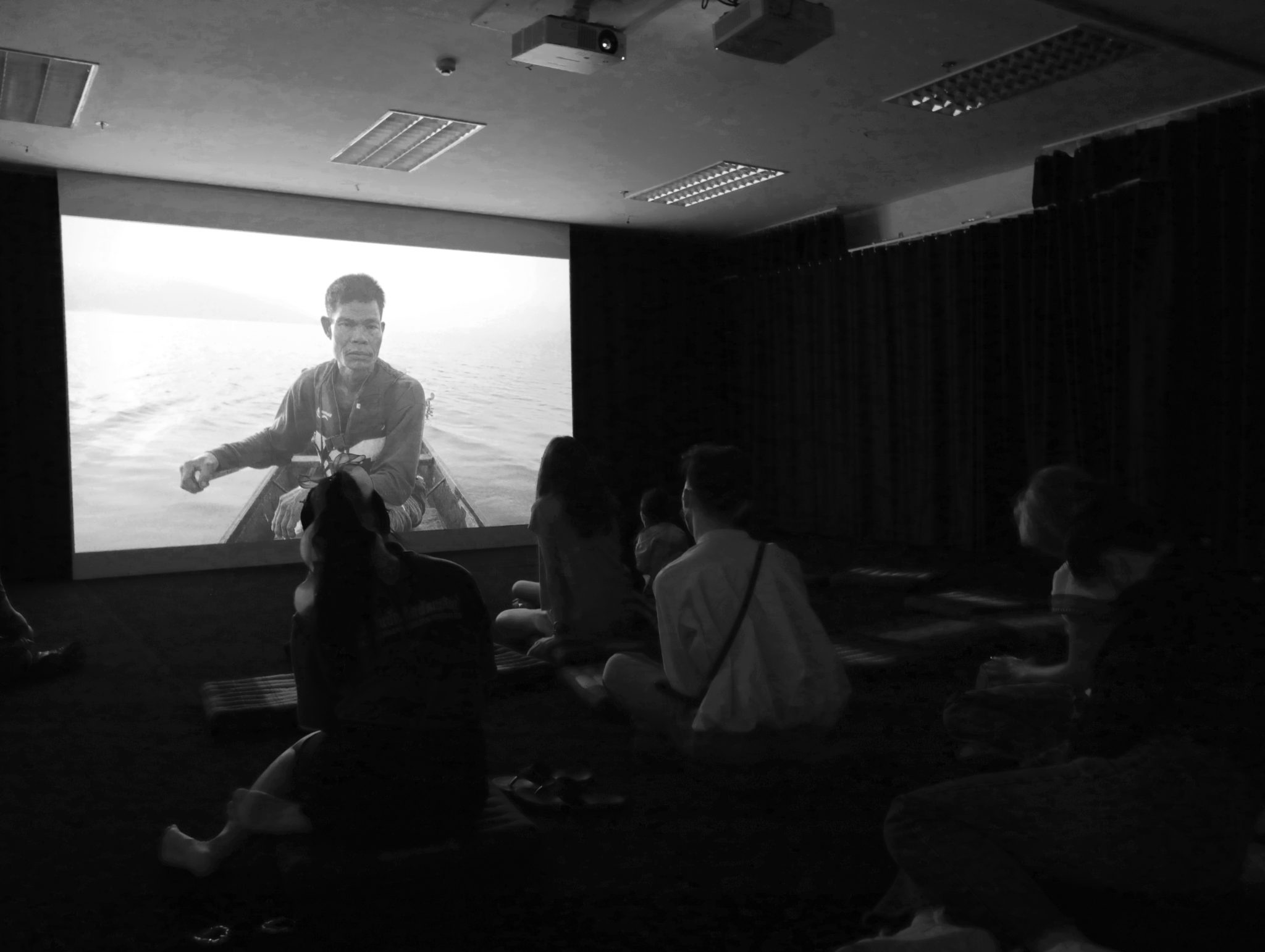The Thai artist’s work captures resilience and activism along the Mekong, contending with the country’s entanglement of power and ecology
‘To live with precarity’, writes anthropologist Anna L. Tsing in The Mushroom at the End of the World (2015), ‘requires more than railing at those who put us here… We might look around to notice this strange new world, and we might stretch our imaginations to grasp its contours.’ Tsing, in her tale of commercial and ecological repair amidst state and capitalist devastation of natural landscapes, helps that process along by describing the hardiness of the wild matsutake mushroom. Northern Thai artist Som Supaparinya, in contrast, has done it by training her filmmaker lens on the hardiness of Thai fisherfolk. In her two-channel video Two Sides of the Moon (2021, part of the last Thailand Biennale), the contours of their strange new world – of precarious livelihoods eked out along a changing waterway – are outlined, in part, by the raw candour of their testimonies. “Before, during the dry season, there was no water but a lot of fish,” an old fisherman grumbles at one point, as his paddling slowly propels his thin wooden boat up Thailand’s Mun River, a tributary of the Mekong. “In the past, the river was full of islands, lots of birds and field mice. There were so many water birds,” he says while reeling in an ornate bamboo fish trap, only for his lament to be cut short. “There are no fish, that’s why the rice bran bait is still there,” he then complains as he holds up the hollow, empty trap for the camera.
Such scenes capture, in unembellished monochrome, a pervasive phenomenon across the vast Mekong River basin: the upending of riparian ways of life, the disruption to livelihoods and bodies of situated knowledge arising from the uptake of hydropower. Centred on life downstream at Thailand’s Pak Mun Dam (a controversial ‘barrage dam’ and ‘run-of-the-river’ hydroelectric plant completed in 1994), Two Sides of the Moon ostensibly depicts the adverse environmental impacts of the Mun’s erratic, man-managed rhythms – impacts already observed and documented by river communities, research bodies and embedded ethnographers. In this sense, Supaparinya’s survey isn’t extraordinary. Her interlocutor’s empty nets and grousing about falling yields, for example, anecdotally attest to dramatic fish-stock declines logged by the World Commission on Dams as far back as the early 2000s.
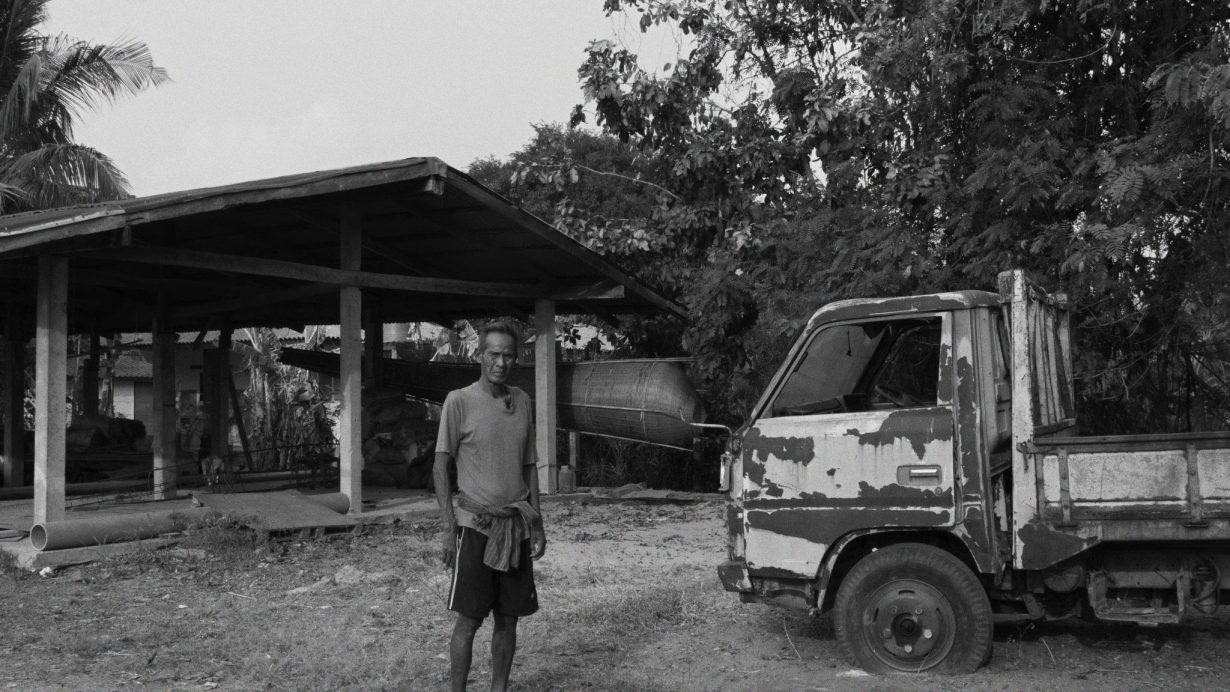
Instead, the potency of Two Sides of the Moon – a work that bears many hallmarks of observational documentary and slow cinema – rests largely upon its placid yet critically engaged powers of visual description: a sensorial approach that renders conscious the Mun’s temporal rhythms and a mosaic of ontological entanglements, as well as its disequilibrium.
‘In the wake of the dams,’ explains Andrew Alan Johnson in his book Mekong Dreaming: Life and Death along a Changing River (2020), ‘the ways in which one dwells with the river fail… And as previously known qualities of the river cease to be, water reemerges as something unreadable, something under the sway of a distant force.’ Supaparinya tracks this stealthy disturbance by studiously capturing the Mun’s surface motions: ripples, eddies and cadences now dissociated, the fisherman explains, from a yearly pulse synchronised to the onset of rainy season. Over the 31-minute duration of Two Sides of the Moon, her flowing and graceful sonic and visual evaluation – a choreographed counterchallenge to extractive hydro-hegemony – builds an impressionistic tableau of a daunting ecology, a riversphere in quiet disarray. Despite all the grit and sweat on display, we can sense the disruptive character is someplace offscreen – and somehow against nature.

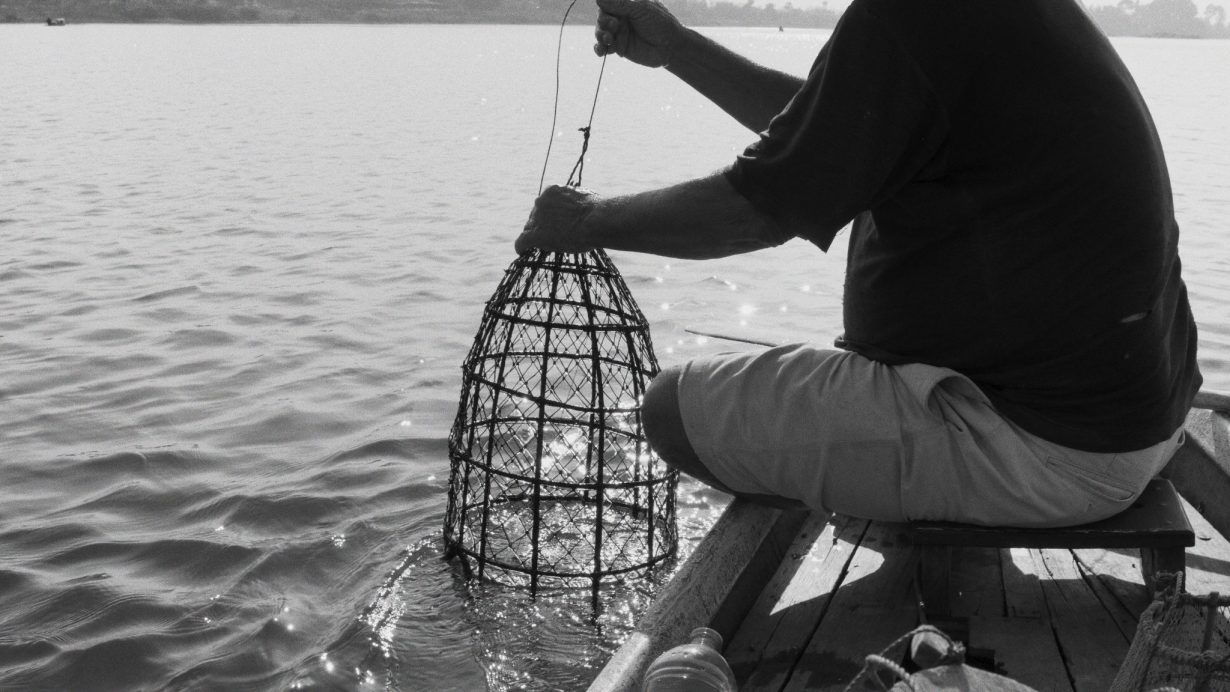
This oneiric means of approach, attuned to the distant forces wielding unchecked dominion over landscapes, is typical of the Chiang Mai-based artist’s ongoing ‘electricity generation’ series. When Need Moves the Earth (2014) pairs popping electromagnetic static and ambient sounds – birds chirping and water rushing – with three channels of footage drawn from two sites administered by Thailand’s electricity generating authority. Three cameras alternate between prowling the turbine hall, control room, transformers and precisely regulated waters of Kanchanaburi province’s Srinagarind Dam, and between surveying dirty grunt work and thudding explosions at Lampang province’s Mae Moh lignite coal mine. Linking both these sites of extraction is a high risk of manmade earthquakes. But, again, while clearly rooted in environmental concerns and grievances, the work is descriptive rather than accusatory. A similar ambivalence underpins 10 Places in Tokyo (2016): an immersive ten-channel installation, suffused in red light, centred on footage shot at the top ten electricity-consuming sites in Tokyo – not so much a clarion call for a rethink of nuclear power as an equable immersion in the senses, conceived amid the fallout of the Fukushima disaster.

By drawing our attention to the minutiae and movements of precarious terrains, both organic and manmade – a ‘hyperaestheticisation’ of the ethical-political kind espoused by Forensic Architecture’s Eyal Weizman – these works invite us to think loosely about how, and by whom, Asia’s power is generated, and to question our own complicity and agency in regards to flagrant displays of ecocide or anthropocentrism.
Other works – installations of a more fomenting strain – betray Supaparinya’s dovetailing urge to address the political inertia of the Thai nation-state, but do so through a similar modality of seeing and hearing. Take Roundabout at km 0 (2017), a videowork now showing in After Hope: Videos of Resistance at the Peabody Essex Museum in Salem, US, for example. Visually it comprises no more than a few blurred frames of daily life at Bangkok’s Democracy Monument, which marks the starting point of Thailand’s national highway system. But shown alongside audio recordings of protests pulled from YouTube, it telegraphs a stark message: the country’s ideological troubles radiate out, like sound waves or tremors, from here – Thai democracy’s troubled ground-zero.
It is but one of a phalanx of antiauthoritarian gestures that Supaparinya – whose other social engagements include cofounding Chiang Mai Art Conversation (a nonprofit organisation promoting art in the city) and directing Asian Culture Station (a shortlived Chiang Mai venue for regional arts exchanges) – has under her belt, from an installation consisting of framed collages of former Thai prime ministers and torn photocopies of past constitutions (Novel Without a Name, 2016) to a sound piece that used a computer-generated composition to reconfigure protest speeches and poems by political and human rights activists into native birdsong (Speeches of the unheard, 2021). Supaparinya is most efficient and captivating, however, when on the move, particularly when her camera is drifting or bobbing in riverscapes that feel less like passive interstices of the energy industry than active arenas, sites of contestation from which we can learn and even take heart. In the last scene of Two Sides of the Moon, a fisherman climbs into the rusting jeep he’s long used to drive to protests against the Pak Mun Dam. The look in his eyes suggests the attritional war for sovereignty over the water is set to continue.
Resilience amid precarity also permeates the equally languorous A Separation of Sands and Islands (2018), which centres on images of gushing waters, bridges and weirs sourced from various points along the lower, dam-afflicted Mekong. For this, Supaparinya traced the history of French colonial trade and expansionism in Laos by following the route of the late-nineteenth-century explorers Louis Delaporte and Francis Garnier, as recorded in their travelogue, A Pictorial Journey on the Mekong: Cambodia, Laos and Yunnan (1866–68).

Film writer Philippa Lovatt noted both the destruction, and the sense of history repeating, in a 2021 interview with Supaparinya: ‘Just as in the colonial era, cultures, rituals, and local cosmologies are swept away alongside communities when they become part of the “submersion zone”.’ Yet we also find succour in the ambient sounds like traders chatting, and the small yet affirmational displays of human agency striking out amid nature’s elemental force. In that interview, Supaparinya explains: ‘The idea came from my trip to Chiang Rai (Northern Thailand) to visit sites and meet with activists who stopped the Chinese attempt to demolish the rocks and islets on the river to make way for larger ships to pass through’. Something of that desire to resist remote authority and lay claim to endangered waters is embodied by these charged vignettes of quotidian life: a man teetering on rocks amid raging rapids, for example.
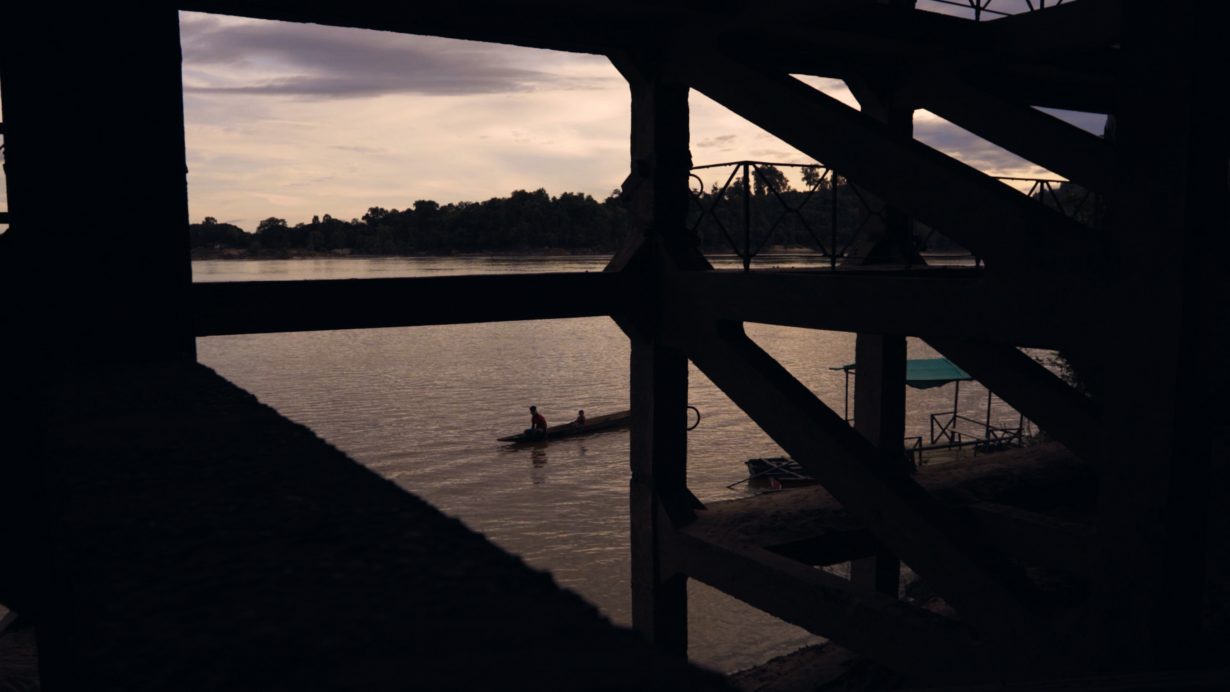
‘What if… precarity is the condition of our time – or, to put it another way, what if our time is ripe for sensing precarity?’ writes Tsing. Across mainland Southeast Asia, legions of artists anxious about the environmental, socioeconomic, nonhuman and spiritual fate of the Mekong and its tributaries endorse this suggestion. Vietnamese artist Thao Nguyen Phan, for example, has mined the magical yet disrupted relations that humans share with the Mekong’s extended spirit world. Recently in Supaparinya’s homeland, Ruangsak Anuwatwimon has combed its banks for dead organisms, and artist-activist ubatsat produced largescale paintings of its threatened rockscapes. All these works are broadsides directed at forces proving even more overpowering than a gushing torrent that begins as a trickle high up in the Tibetan Plateau: unchecked state and corporate power, the neocolonialism of the Greater Mekong Subregion’s China-led energy policies – the region’s rapacious big fish. Supaparinya’s work flows wide and deep in this regard, too – and few reveal the contours of precarity so assiduously or vigorously. Her best works are serene and accretive: images are layered, like so much sand or alluvium, to build a heightened atmosphere more majestic – and disquieting – than the sum of its parts. We sense a deep attachment, a fey understanding.
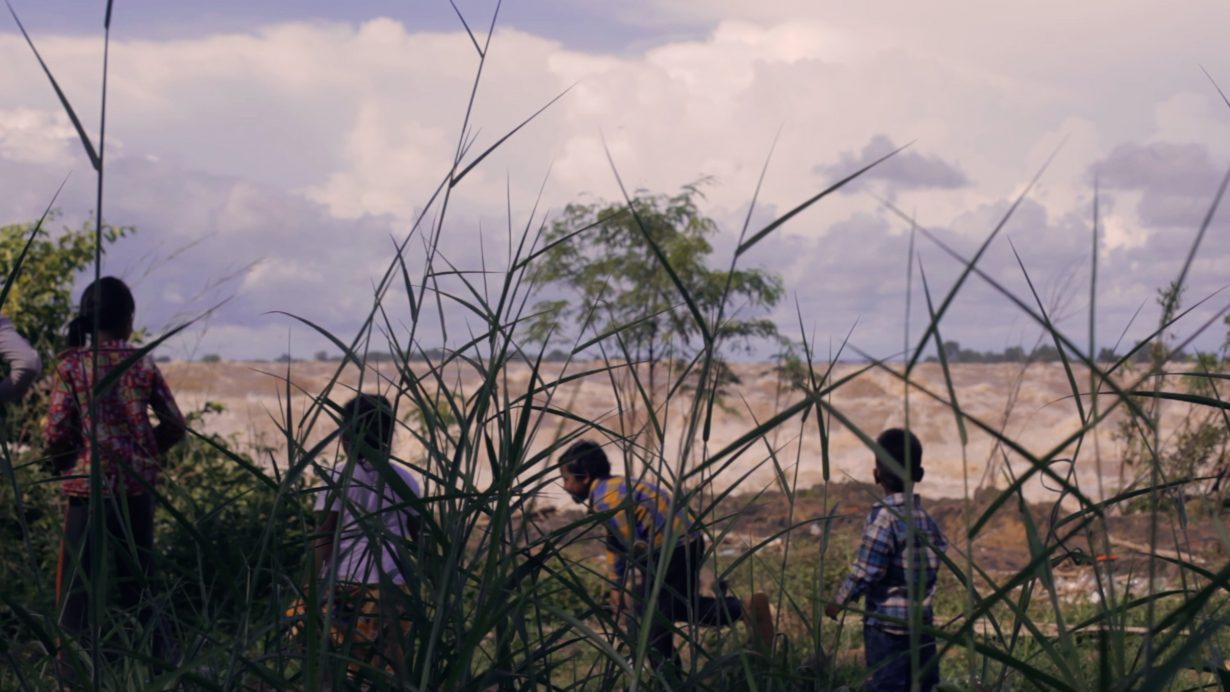
‘I can see the landscape has changed very quickly since my childhood until recent times. It’s very quick, which is quite different from my grandparents’ and my parents’ time,’ she once said of Lamphun, the ancient town near Chiang Mai where she grew up. Rooted in this sense of rapid loss, My Grandpa’s Route Has Been Forever Blocked (2012) – an exquisite and emblematic work that sparked her interest in electricity production – is a two-channel installation centred on her retracing of a stretch of the north’s 658km-long Ping River that her grandfather, a former dried-meats trader and hired hand for a timber shipping company, used to ply. We see what she found in lieu of a clear path: images of dams, weirs, floodgates and riverbanks on the left screen; cruise ships and pleasure boats swanning across the vast, mountain-fringed lake formed by the Bhumibol Dam – the country’s highest – on the right.
Supaparinya’s observations are bound up not only with transnational concerns about hydropolitics and the material decline of ecological habitats, but also with Thailand’s ‘geo-body’, as historian Thongchai Winichakul has described the spatial framework of the mapped and geographic nature of Siamese nationhood and nationalism. Water within Thailand, far from merely answering farmer’s prayers or washing away bad luck or swirling with animist mythologies, plays an outsized role in its territorial, political and royal imaginings. Dams are also crude symbols of the late King Bhumibol Adulyadej’s mythologised interest in water management, as their naming after him and other members of his family suggests.
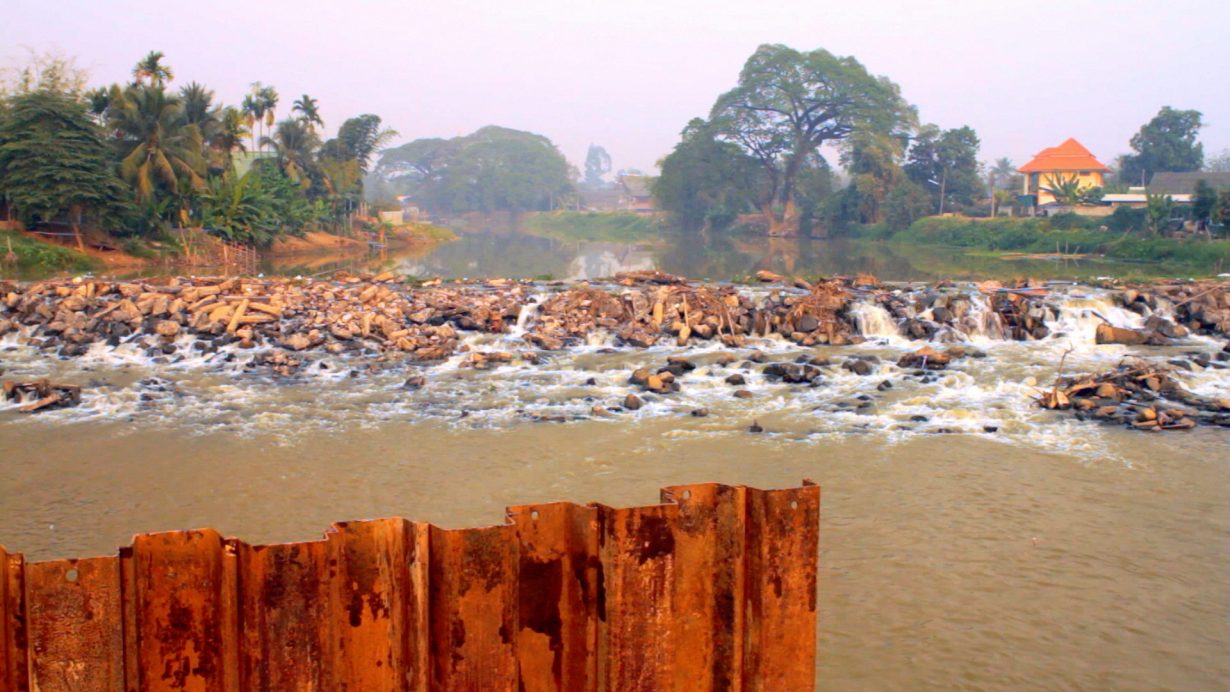
In My Grandpa’s Route…, the Thai geo-body – the water, mountains, sky, concrete, people – appears to quietly acquiesce with the imported principles of hydraulic engineering and, by extension, the modernising nation-state that imposed them on remote corners of the Kingdom in the late twentieth century. But in Supaparinya’s hands, through her careful suturing of sound and image, her long takes of the water’s unnatural flow and flux, there rises a mounting suspicion that the sunlit harmony on show may be all surface. “If this dam were to break, the water would flow out and we would all die,” says a ferry driver with a chuckle at one point. “Everything would disappear.”
Recently, Mekong communities concerned about the threats posed by upstream hydropower, and driven by an animistic worldview, have begun asking: can a river have its own legal personhood and rights? In this uncanny, career-defining work, Supaparinya insinuates, through an affective articulation of absence and control, a parallel consideration: that the forests drowned, fish confused and communities displaced by the edicts and actions of the Thai nation-state may have their own essential, enduring souls too.
Som Supaparinya’s work is currently included in 21st Century Thai Contemporary Art, DC Collection, Chiang Mai, and in After Hope: Videos of Resistance, Peabody Essex Museum, Salem, Massachusetts, through 31 December
